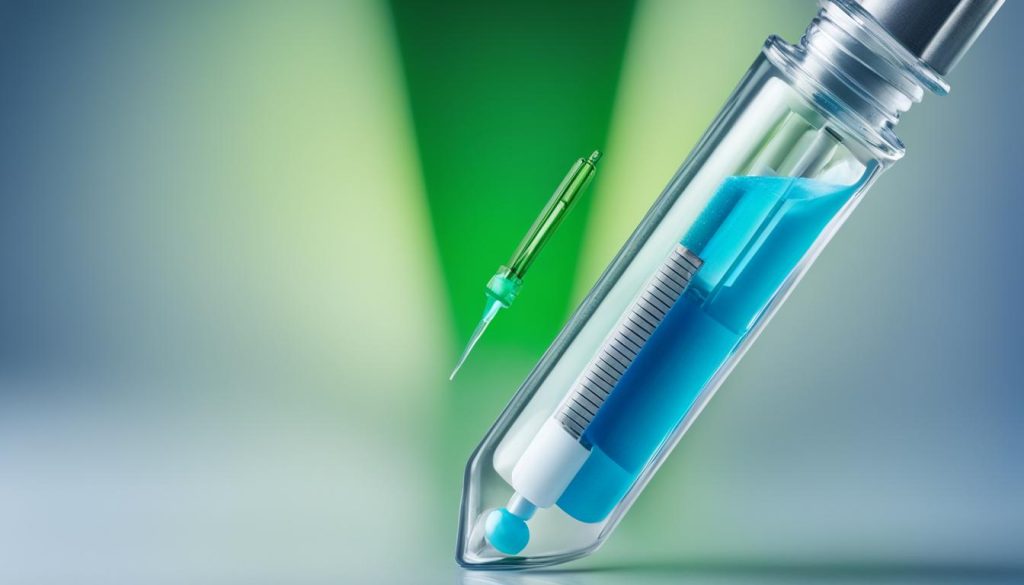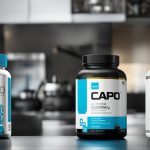Testosterone therapy can provide numerous benefits for individuals with low testosterone levels. However, it is important to determine the appropriate dosage to ensure optimal health. Several factors need to be considered when prescribing a safe testosterone dosage, including age, overall health, symptoms, and severity of testosterone deficiency. The dosage also varies depending on the method of administration, such as injections, gels, or patches.
Key Takeaways:
- Safe testosterone dosage is crucial for optimal health in individuals undergoing testosterone therapy.
- Dosage should be determined based on factors like age, overall health, symptoms, and severity of testosterone deficiency.
- Method of administration, such as injections, gels, or patches, affects the dosage.
- A healthy testosterone level for men ranges from 300 ng/dL to 1000 ng/dL.
- Maintaining testosterone levels within 400-600 ng/dL is recommended for optimal results.
Factors to Consider for Testosterone Dosage
When determining the appropriate testosterone dosage, several factors need to be considered. For men, the dosage will depend on their age, overall health, and symptoms of testosterone deficiency. Women may also require testosterone therapy, but the dosage will be adjusted accordingly. Some individuals, such as bodybuilders, may require higher testosterone dosages to support their specific goals.
It is important to note that testosterone therapy can have side effects, including worsening of sleep apnea, gynecomastia, polycythemia, and elevated prostate-specific antigen (PSA) levels. However, when used appropriately, testosterone therapy can provide benefits such as increased muscle strength, improved cognitive function, and overall well-being.
Testosterone therapy can be highly beneficial for individuals with testosterone deficiencies, but it should always be prescribed and monitored by a healthcare professional to ensure safety and effectiveness.
Testosterone dosage varies based on individual factors, including gender, health status, and specific goals. Here are some key considerations:
- Testosterone Dosage for Men: For men, the dosage is determined by factors such as age, overall health, and the extent of testosterone deficiency. It is important to find the optimal dosage that restores testosterone levels without causing adverse side effects. Regular monitoring and adjustments by a healthcare professional are essential to ensure safety and efficacy.
- Testosterone Dosage for Women: Women may also require testosterone therapy for conditions like polycystic ovary syndrome (PCOS) or low libido. The dosage for women is typically lower than that for men, and it should be carefully adjusted to avoid virilization or other unwanted side effects.
- Testosterone Dosage for Bodybuilding: Bodybuilders and athletes may require higher testosterone dosages to enhance muscle growth and performance. However, it is crucial to follow safe and responsible usage guidelines, as excessive testosterone levels can lead to serious health risks and adverse effects.
While testosterone therapy offers numerous benefits, it is important to be aware of potential side effects and risks. Regular monitoring and open communication with a healthcare professional can help mitigate any potential complications and optimize the benefits of testosterone therapy.
Risks and Side Effects of Testosterone Dosage
Testosterone therapy, like any medication, comes with potential side effects and risks. It is important to be aware of these possible outcomes and discuss them with a healthcare professional. Some common side effects of testosterone dosage include:
- Worsening of sleep apnea
- Gynecomastia (enlarged breast tissue in men)
- Polycythemia (increased red blood cell count)
- Elevated prostate-specific antigen (PSA) levels
However, many individuals experience significant benefits from testosterone therapy when used appropriately. Some of the potential benefits of testosterone dosage include:
- Increased muscle strength and mass
- Improved cognitive function and memory
- Enhanced libido and sexual function
- Boosted energy levels and overall well-being
It is crucial to have a comprehensive understanding of the risks and benefits associated with testosterone therapy in order to make informed decisions and ensure the best possible outcomes.
| Factors | Testosterone Dosage Range |
|---|---|
| Normal Testosterone Level for Men | 300-1000 ng/dL |
| Target Testosterone Level for Men | 400-600 ng/dL |
| Average Testosterone Dosage for Hypogonadism | 100-200 mg per injection |
The Safest Testosterone Dosage
When undergoing testosterone therapy, finding the safest dosage is crucial to ensure optimal results and minimize potential side effects. The appropriate testosterone dosage varies depending on factors such as the individual’s medical condition, the specific type of testosterone medication used, and their body’s response to treatment. Hormone replacement therapy, often used for conditions like hypogonadism or low testosterone, typically involves testosterone injections.
The recommended dosage for hormone replacement therapy typically ranges from 100-200 mg per injection. However, it is important to note that the starting dose is usually lower, around 50-75 mg, and may be gradually increased over time to achieve the desired results. This approach allows for the careful monitoring of the individual’s testosterone levels and response to treatment.
Compared to other methods such as gels or patches, testosterone injections are generally considered more effective in providing testosterone treatment. The injectable form ensures a controlled release of testosterone into the body, maintaining testosterone levels within the desired range. This helps minimize the risk of hormonal imbalances and other adverse side effects.
To summarize, the safest testosterone dosage for hormone replacement therapy typically involves testosterone injections. The dosage should be personalized based on the individual’s condition and response to treatment, with a starting dose of 50-75 mg and gradual adjustments over time. This approach provides the best opportunity to maintain testosterone levels within the desired range while minimizing the risk of side effects.

| Testosterone Dosage | Method of Administration | Benefits |
|---|---|---|
| 100-200 mg per injection | Testosterone Injections | – Controlled release of testosterone – Effective in maintaining testosterone levels – Minimizes the risk of side effects |
| Varies | Gels or Patches | – Convenient application methods – May not provide as consistent testosterone levels as injections – Side effects may vary |
Recognizing When a Dosage Needs Adjustment
It is essential to be aware of signs that indicate that a testosterone dosage may not be right for an individual. Adverse side effects such as acne, hair loss, mood swings, or trouble sleeping may indicate that the dosage is too high or too low. Lack of improvement in symptoms despite the treatment may also suggest that the prescribed dosage is not working effectively. Emotional changes, such as irritability, anxiety, or depression, can also be a sign of an inappropriate dosage. If any of these signs occur, it is important to discuss them with a healthcare provider to consider adjusting the dosage or exploring alternative treatment options.

It is crucial to monitor the individual’s response to treatment and make necessary adjustments to the dosage to ensure optimal benefits. Each person may respond differently to testosterone therapy, and finding the right dosage is a personalized process. Regular follow-ups with a healthcare provider can help track progress and identify any need for dosage adjustments.
Recognizing when a testosterone dosage needs adjustment is a vital step in optimizing the treatment’s effectiveness and minimizing potential side effects. Open communication with a medical professional is key to ensuring the dosage is tailored to individual needs, promoting overall well-being and satisfaction with the treatment.
Conclusion
Determining the safe testosterone dosage is vital for individuals who undergo testosterone therapy. When prescribing the dosage, factors such as age, overall health, symptoms, and specific goals should be taken into account. It is crucial to closely monitor the patient’s response to treatment and make necessary adjustments to ensure safety and effectiveness.
By maintaining the optimal testosterone dosage, individuals can experience significant benefits, including improved muscle strength, enhanced cognitive function, and overall well-being. However, it is important to consult with a medical professional throughout the treatment process to receive proper guidance and support.
Remember that each individual’s testosterone dosage needs may vary, so it is crucial to work closely with a healthcare provider to find the right balance. With the appropriate testosterone dosage, individuals can achieve optimal health and maximize the benefits of testosterone therapy.
FAQ
What factors are considered when determining the appropriate testosterone dosage?
Factors such as age, overall health, symptoms, and severity of testosterone deficiency are considered when prescribing the dosage.
Is the testosterone dosage different for men and women?
Yes, the dosage may vary depending on the individual’s gender. Women may require testosterone therapy, but the dosage will be adjusted accordingly.
Do bodybuilders require different testosterone dosages?
Yes, bodybuilders may require higher testosterone dosages to support their specific goals.
What are the potential side effects of testosterone dosage?
Side effects can include worsened sleep apnea, gynecomastia, polycythemia, and elevated prostate-specific antigen (PSA) levels.
What are the benefits of testosterone dosage?
Benefits can include increased muscle strength, improved cognitive function, and an overall sense of well-being.
What is considered the safest testosterone dosage for hormone replacement therapy?
The safest dosage will depend on the individual’s condition, the type of testosterone medication used, and their body’s response to treatment. It is best to consult with a medical professional for personalized guidance.
How do I know if a testosterone dosage needs adjustment?
Signs such as acne, hair loss, mood swings, trouble sleeping, lack of symptom improvement, or emotional changes may indicate that the dosage needs adjustment. Consult with a healthcare provider for further evaluation.
Why is it important to monitor the response to testosterone treatment?
Monitoring the response to treatment helps ensure its safety and effectiveness. By closely monitoring the individual’s progress, the dosage can be adjusted as needed to optimize results.
How can I determine the proper testosterone dosage for optimal health?
Determining the proper dosage involves considering factors such as age, overall health, symptoms, and individual goals. It is essential to consult with a medical professional for personalized guidance.
What are the potential benefits of testosterone therapy?
Testosterone therapy can provide benefits such as increased muscle strength, improved cognitive function, and an overall sense of well-being.

